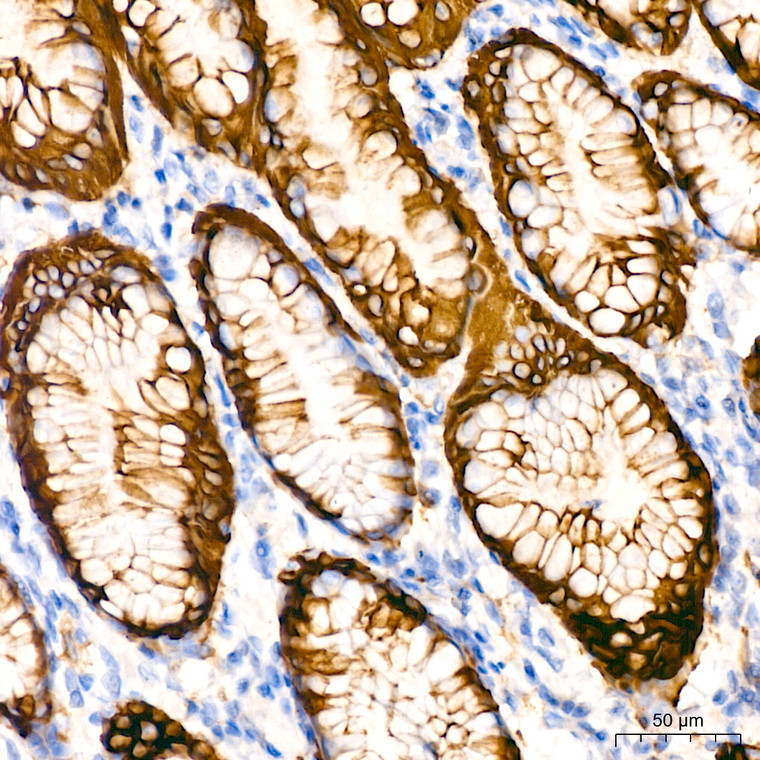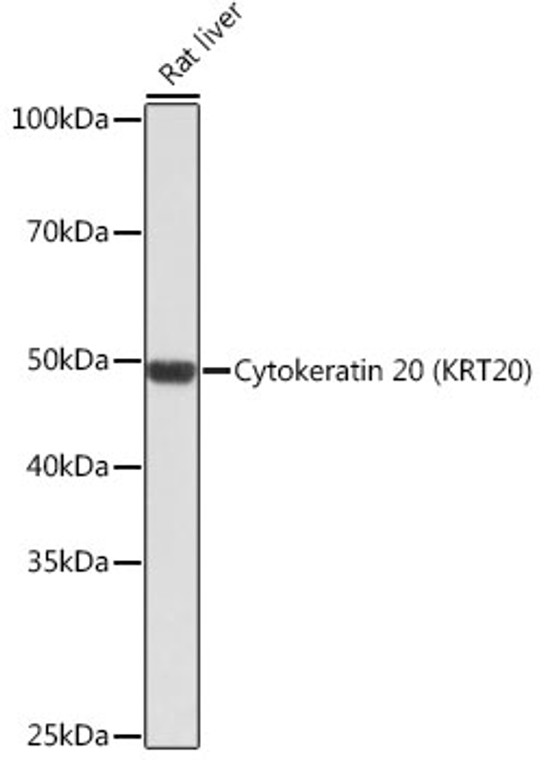| Host: |
Rabbit |
| Applications: |
WB/IHC |
| Reactivity: |
Human/Rat |
| Note: |
STRICTLY FOR FURTHER SCIENTIFIC RESEARCH USE ONLY (RUO). MUST NOT TO BE USED IN DIAGNOSTIC OR THERAPEUTIC APPLICATIONS. |
| Short Description: |
Rabbit monoclonal antibody anti-Cytokeratin 20 (325-424) is suitable for use in Western Blot and Immunohistochemistry research applications. |
| Clonality: |
Monoclonal |
| Clone ID: |
S9MR |
| Conjugation: |
Unconjugated |
| Isotype: |
IgG |
| Formulation: |
PBS with 0.02% Sodium Azide, 0.05% BSA, 50% Glycerol, pH7.3. |
| Purification: |
Affinity purification |
| Dilution Range: |
WB 1:500-1:1000IHC-P 1:50-1:200 |
| Storage Instruction: |
Store at-20°C for up to 1 year from the date of receipt, and avoid repeat freeze-thaw cycles. |
| Gene Symbol: |
KRT20 |
| Gene ID: |
54474 |
| Uniprot ID: |
K1C20_HUMAN |
| Immunogen Region: |
325-424 |
| Immunogen: |
A synthetic peptide corresponding to a sequence within amino acids 325-424 of human Cytokeratin 20 (KRT20) (P35900). |
| Immunogen Sequence: |
LANLQSLLSSLEAQLMQIRS NMERQNNEYHILLDIKTRLE QEIATYRRLLEGEDVKTTEY QLSTLEERDIKKTRKIKTVV QEVVDGKVVSSEVKEVEENI |
| Tissue Specificity | Expressed predominantly in the intestinal epithelium. Expressed in luminal cells of colonic mucosa. Also expressed in the Merkel cells of keratinized oral mucosa.specifically at the tips of some rete ridges of the gingival mucosa, in the basal layer of the palatal mucosa and in the taste buds of lingual mucosa. |
| Post Translational Modifications | Hyperphosphorylation at Ser-13 occurs during the early stages of apoptosis but becomes less prominent during the later stages. Phosphorylation at Ser-13 also increases in response to stress brought on by cell injury. Proteolytically cleaved by caspases during apoptosis. Cleavage occurs at Asp-228. |
| Function | Plays a significant role in maintaining keratin filament organization in intestinal epithelia. When phosphorylated, plays a role in the secretion of mucin in the small intestine. |
| Protein Name | Keratin - Type I Cytoskeletal 20Cytokeratin-20Ck-20Keratin-20K20Protein It |
| Database Links | Reactome: R-HSA-6805567Reactome: R-HSA-6809371 |
| Cellular Localisation | Cytoplasm |
| Alternative Antibody Names | Anti-Keratin - Type I Cytoskeletal 20 antibodyAnti-Cytokeratin-20 antibodyAnti-Ck-20 antibodyAnti-Keratin-20 antibodyAnti-K20 antibodyAnti-Protein It antibodyAnti-KRT20 antibody |
Information sourced from Uniprot.org
12 months for antibodies. 6 months for ELISA Kits. Please see website T&Cs for further guidance








![Western blot analysis of lysates from wild type (WT) and Cytokeratin 20 (Cytokeratin 20 (KRT20) ) knockout (KO) HeLa cells, using [KO Validated] Cytokeratin 20 (KRT20) Rabbit polyclonal antibody (STJ119970) at 1:1000 dilution. Secondary antibody: HRP Goat Anti-Rabbit IgG (H+L) (STJS000856) at 1:10000 dilution. Lysates/proteins: 25 Mu g per lane. Blocking buffer: 3% nonfat dry milk in TBST. Detection: ECL Basic Kit. Exposure time: 1s. Western blot analysis of lysates from wild type (WT) and Cytokeratin 20 (Cytokeratin 20 (KRT20) ) knockout (KO) HeLa cells, using [KO Validated] Cytokeratin 20 (KRT20) Rabbit polyclonal antibody (STJ119970) at 1:1000 dilution. Secondary antibody: HRP Goat Anti-Rabbit IgG (H+L) (STJS000856) at 1:10000 dilution. Lysates/proteins: 25 Mu g per lane. Blocking buffer: 3% nonfat dry milk in TBST. Detection: ECL Basic Kit. Exposure time: 1s.](https://cdn11.bigcommerce.com/s-zso2xnchw9/images/stencil/300x300/products/98755/382808/STJ119970_1__87130.1713151301.jpg?c=1)
